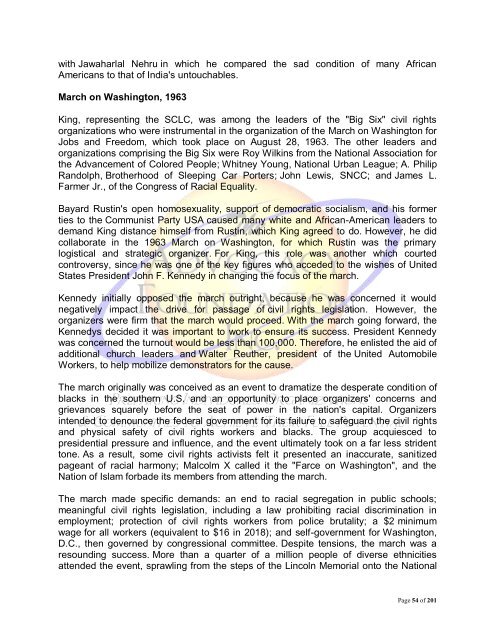Create successful ePaper yourself
Turn your PDF publications into a flip-book with our unique Google optimized e-Paper software.
with Jawaharlal Nehru in which he compared the sad condition <strong>of</strong> many African<br />
Americans to that <strong>of</strong> India's untouchables.<br />
March on Washington, 1963<br />
King, representing the SCLC, was among the leaders <strong>of</strong> the "Big Six" civil rights<br />
organizations who were instrumental in the organization <strong>of</strong> the March on Washington for<br />
Jobs and Freedom, which took place on August 28, 1963. <strong>The</strong> other leaders and<br />
organizations comprising the Big Six were Roy Wilkins from the National Association for<br />
the Advancement <strong>of</strong> Colored People; Whitney Young, National Urban League; A. Philip<br />
Randolph, Brotherhood <strong>of</strong> Sleeping Car Porters; John Lewis, SNCC; and James L.<br />
Farmer Jr., <strong>of</strong> the Congress <strong>of</strong> Racial Equality.<br />
Bayard Rustin's open homosexuality, support <strong>of</strong> democratic socialism, and his former<br />
ties to the Communist Party USA caused many white and African-American leaders to<br />
demand King distance himself from Rustin, which King agreed to do. However, he did<br />
collaborate in the 1963 March on Washington, for which Rustin was the primary<br />
logistical and strategic organizer. For King, this role was another which courted<br />
controversy, since he was one <strong>of</strong> the key figures who acceded to the wishes <strong>of</strong> United<br />
States President John F. Kennedy in changing the focus <strong>of</strong> the march.<br />
Kennedy initially opposed the march outright, because he was concerned it would<br />
negatively impact the drive for passage <strong>of</strong> civil rights legislation. However, the<br />
organizers were firm that the march would proceed. With the march going forward, the<br />
Kennedys decided it was important to work to ensure its success. President Kennedy<br />
was concerned the turnout would be less than 100,000. <strong>The</strong>refore, he enlisted the aid <strong>of</strong><br />
additional church leaders and Walter Reuther, president <strong>of</strong> the United Automobile<br />
Workers, to help mobilize demonstrators for the cause.<br />
<strong>The</strong> march originally was conceived as an event to dramatize the desperate condition <strong>of</strong><br />
blacks in the southern U.S. and an opportunity to place organizers' concerns and<br />
grievances squarely before the seat <strong>of</strong> power in the nation's capital. Organizers<br />
intended to denounce the federal government for its failure to safeguard the civil rights<br />
and physical safety <strong>of</strong> civil rights workers and blacks. <strong>The</strong> group acquiesced to<br />
presidential pressure and influence, and the event ultimately took on a far less strident<br />
tone. As a result, some civil rights activists felt it presented an inaccurate, sanitized<br />
pageant <strong>of</strong> racial harmony; Malcolm X called it the "Farce on Washington", and the<br />
Nation <strong>of</strong> Islam forbade its members from attending the march.<br />
<strong>The</strong> march made specific demands: an end to racial segregation in public schools;<br />
meaningful civil rights legislation, including a law prohibiting racial discrimination in<br />
employment; protection <strong>of</strong> civil rights workers from police brutality; a $2 minimum<br />
wage for all workers (equivalent to $16 in 2018); and self-government for Washington,<br />
D.C., then governed by congressional committee. Despite tensions, the march was a<br />
resounding success. More than a quarter <strong>of</strong> a million people <strong>of</strong> diverse ethnicities<br />
attended the event, sprawling from the steps <strong>of</strong> the Lincoln Memorial onto the National<br />
Page 54 <strong>of</strong> 201

















